Back in 1980, I got a fever and the only prescription was John, Paul, George and Ringo.
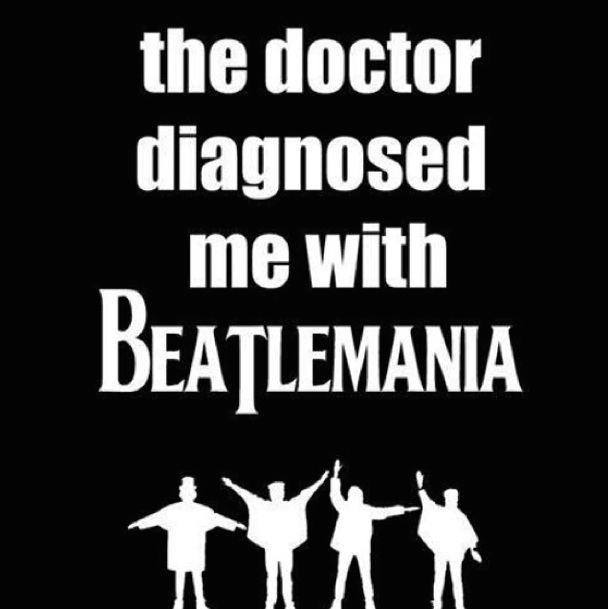
Since then, I’ve wanted to go to Liverpool, the Fab Four’s hometown. It’s difficult to schedule a trip to Liverpool though. It doesn’t top most non-Beatlemaniac vacation lists, so every year, I’ve told myself, “Maybe next year.” Then I read Tune In, the first of a planned Beatles trilogy by Mark Lewisohn.

I’ve read dozens of Beatles books and this is my favorite by far because it is so well-researched. It follows the Beatles from their childhoods through the end of 1962, just before the band became a worldwide phenomenon. Actually, it starts before the Beatles’ childhoods, with an exploration of the history of the port city of Liverpool, which thrived on the slave trade in the 18th century. (There’s now an International Slavery Museum in Liverpool that tells this history.) In the 19th century, Liverpool attracted hundreds of thousands of Irish immigrants who were fleeing famine in their homeland, as well as immigrants from all over Europe. Lewisohn places the Beatles’ families in context in the history of Liverpool, tracing all of them back to the 1800s. I was amazed by how many out-of-wedlock children there were back in the day: George Harrison’s maternal grandmother had seven of them between 1905 and 1924. And Richard Starkey — the future Ringo Starr — would have had the last name Parkin except his great-grandmother took up with a married man named Starkey. To avoid gossip, she changed her name, and that of her son — Ringo’s future grandfather — to “Starkey.”
Speaking of Ringo, I never before understood what harrowing childhood health problems he had. First, his appendix ruptured shortly before he turned 7 in 1947. As he was wheeled into an operating room, Richy, as he was known, asked a nurse for a cup of tea. Lewisohn writes: “‘We’ll give you one when you come round,” she answered — by which time ten weeks had passed.” During that time, his mother was warned on three occasions that he wouldn’t survive the night and, even after he came out of that original coma, he spent as many as 16 weeks in and out of consciousness. He didn’t get back home until the summer of 1948! After a few decent years, in May or June 1954, he came down with pleurisy and then tuberculosis, and didn’t get out of the hospital till the end of 1955. It was during that second hospital stay that he first got his hands on a drum, thanks to the the visits of a music teacher who came with a selection of percussion instruments. Richy had coveted a drum seen in the window of a music shop early in 1954, and refused to participate in the music class unless he got a drum instead of the other options of tambourine, cymbal, triangle or maracas. Good thing the teacher gave in to him, eh?
The book was also very enlightening about John’s family, adding a lot of color to the standard black-and-white story that paints John’s mother, Julia, as a ne’er-do-well hussy who abandoned him when he was five years old to his strict, but noble, Aunt Mimi, and who didn’t see her child again till right before her accidental death. Julia certainly was a rebel, but not much wilder than the Harrison and Starkey ancestors earlier in the century. In 1938, when she was 24, she married John’s merchant-seaman father, Alf, “for a dare, a lark,” writes Lewisohn. John was born in 1940, after which the longest time Julia, Alf and child spent together as a family was probably two months. Alf was gone on voyages for long periods of time — during one 18-month period, Julia stopped receiving letters from him, and didn’t even know that Alf had been imprisoned for stealing cargo. When he finally showed up, he found her pregnant with another man’s baby. (That baby, a girl, was, indeed, voluntarily given up for adoption and her name changed from Victoria Elizabeth Lennon to Ingrid Pedersen. Her identity was made public in 1998. She never met her mother or half-brother John Lennon.) After that, Julia took up with another guy, John Dykins, and moved to a small flat in which there was only one double bed to share with her new man and son. Mimi called social services and John ended up with Aunt Mimi and and her husband, George Smith. One day Alf came to the Smith house to take John out and fled with him to a friends’ place in Blackpool. This wasn’t the first time Alf had absconded with John. Julia, now pregnant with a child by Dykins, fetched John back and turned him over to Mimi. Julia visited at first, but Mimi encouraged distance between them, wanting John to be in a less turbulent environment. Julia never lived more than about two miles away and she and John resumed a close relationship in the summer of 1954, when he was 13. Julia shared John’s sense of humor, bought him cool clothes, taught him to play the banjo, encouraged his interest in new music and bought him his first guitar (Aunt Mimi famously told the teenage Lennon, “The guitar’s all very well, John, but you’ll never make a living at it.”) He would spend weekends and then a week at a time at Julia’s house — enough time that her daughters with Dykins, another Julia and Jacqui, thought John was their full brother. John was at Julia’s house on July 15, 1958, when Julia went to visit Mimi at her house, known as “Mendips.” Walking to the bus stop from Mimi’s, Julia was struck and killed by an off-duty cop who was driving unaccompanied although he only had a learner’s permit. Later, John would say:
“It was the worst thing that ever happened to me. We’d caught up so much, me and Julia, in just a few years. We could communicate. We got on. She was great.”
But even more interesting to me — no, inspiring! — were the details of the Beatles’ challenges, hard work and persistence. Recently, I heard someone say that the Beatles didn’t accomplish anything all that radical musically. That they’re kind of middle of the road. It reminded me of the old story of the ignoramus who sees Hamlet and declares that Shakespeare is full of cliches. No! The originals only sound ordinary now because they were so influential that the entire culture imitated them. They SET the new standards. It’s the same progression that clothing designer Charles James described in the fashion world:
“A great designer does not seek acceptance. He challenges popularity, and by the force of his own convictions renders popular in the end what the public hates at first sight.”
Or as I say, “Never Is the Next New Thing™”!
The Beatles really were special, but they weren’t preordained for fame as it often seems in hindsight. They busted their asses for their success. From the start, they did their research, always open-minded to new music from America — especially music by black performers — and adding rare songs that other groups didn’t perform to their repertoire. (Years later, while inducting the Beatles into the Rock and Roll Hall of Fame, Mick Jagger recalled, “England was a real wasteland. England had nothing really to offer as far as pop music was concerned.”) Early on, as teenagers, John Lennon and Paul McCartney started experimenting with writing their own songs. It was unheard for musicians to do this at that point. There were songwriters and there were performers; never the twain did meet. All the Liverpool groups developing at the same time as the Beatles did entire shows of covers. (Even Elvis, a great early influence on the Beatles as well as on the whole rock genre, only has a few songwriting credits, and then just because his hard-ass manager, Colonel Tom Parker, demanded them, not due to any real contribution.)
The Beatles also put in Malcolm Gladwell’s “10,000 hours” of hard work. Any serious fan knows about the shows they played in rough bars in Hamburg, Germany, before they became big. (My grandfather Sam once got me the bootleg Hamburg sessions on vinyl that I begged for. I’m hoping I’ll find that in storage somewhere.) Their lunchtime shows at the Cavern Club in Liverpool generated a fierce local fan base. That kind of work leads to “luck” — in this case, the interest of a furniture-and-record-store executive named Brian Epstein, who became the group’s devoted manager, undeterred by discouragement including the record label Decca’s infamous 1962 rejection of the band. The way Lewisohn writes it, that move made as much sense as a large number of corporate decisions I’ve witnessed first-hand:
“Logic … cannot explain why Decca rejected a group who’d won a newspaper popularity poll, had a fan club and were the biggest band in Liverpool and Hamburg, playing 350 bookings a year, sometimes to as many as three thousand people a night, but then signed and issued records by several semi-professional, non-performing nonentities during 1962, one of whom they promoted as a singing decorator. And … Decca spent more money treating Brian Epstein to lunch to tell him they weren’t signing the Beatles than it would have cost to sign them.”
LOLZ. Of course, part of the problem was the snobbery that London-based companies had towards Liverpool, which they considered a hick town, still struggling to rebuild the ruins from heavy bombing during World War II. So what did those fans matter? Then there was Decca’s belief that “guitar groups are on the way out.” Guitar groups were barely getting started, of course — it was the Beatles who would popularize them — but there had been a little blip of interest which the suits believed would be as short-lived as fads for calypso music and the Twist. I could go on, but I’ll just say that if you’re in any creative industry and frustrated by running up against the Establishment’s lack of vision and imagination, this book has a lot of lessons for you.
This is the book that finally got me to Liverpool. Yep! After finishing this, I told MrB: “I’ve always wanted to go to Liverpool ‘someday.’ ‘Someday’ has arrived!” So, last month, we did it. We flew into nearby Manchester Airport — not Liverpool John Lennon Airport, sadly — and within hours were on a ferry on the River Mersey, listening to a recording of Gerry & the Pacemaker’s hit tribute to the area, “Ferry Cross the Mersey.”
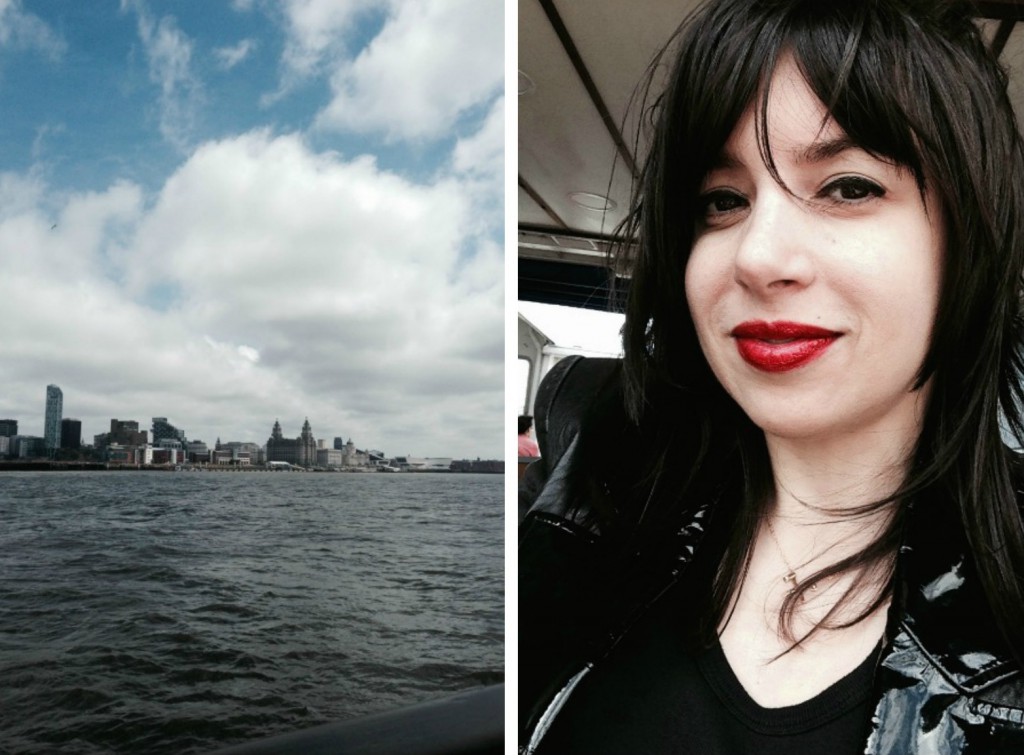
A view of the Mersey on the left. Windblown on the ferry on the right.
The waterfront was beautiful.
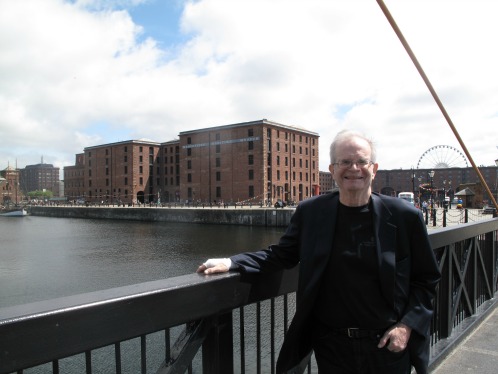
MrB at the docks.
But, naturally, the big excitement was following in the footsteps of the Beatles. I enjoyed the Magical Mystery Tour — and it was a bonus that the tour guide was the brother of Frankie Goes to Hollywood’s Holly Johnson (“I saw your brother at the Ritz in the ’80s!” I told him.)
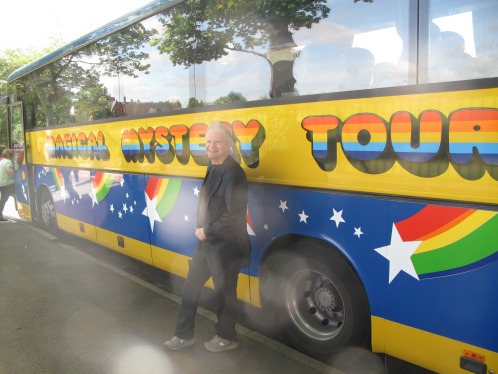
MrB and a bus.
We saw all the important sights, including St. Peter’s Church, where John and Paul met as teenagers. There was also Penny Lane …
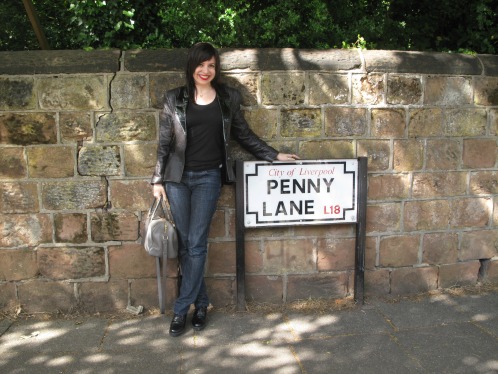
… the Strawberry Field gate (well, it’s a reproduction, but a very nice one!) …
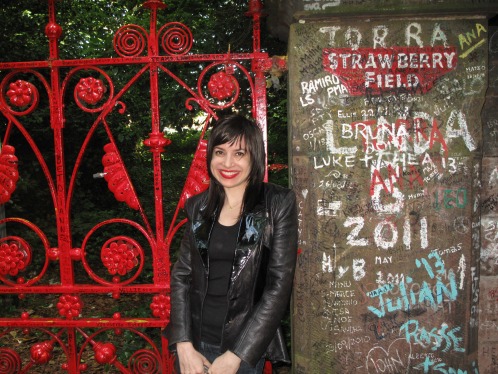
… and all the Beatles’ childhood homes, plus Brian Epstein’s.
We went on a separate tour to go inside John’s and Paul’s houses. Those houses are now owned and operated by the National Trust, which does several tours a day to both houses with just 15 people per tour. Those tours are the only way to get into the houses, so make sure you book early! You’re not allowed to take photos inside, but here is one of me and my real husband lurking outside the door of my almost-husband Paul McCartney’s old house on 20 Forthlin Road.
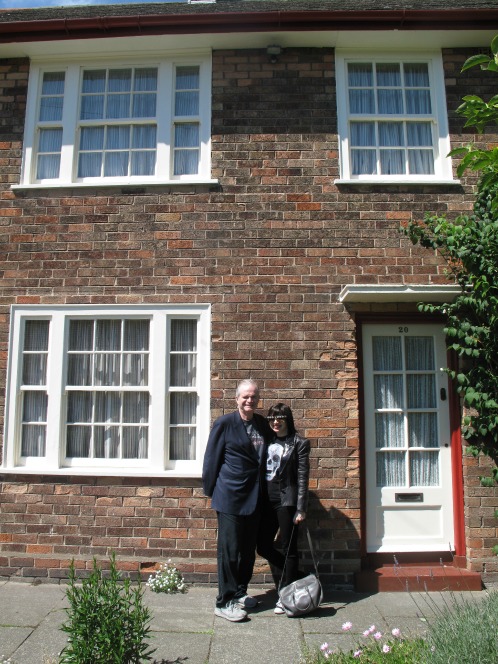
Sylvia, the woman giving the tour at Paul’s house, has occasional interaction with Paul’s brother Mike, who has visited the house. He passes along all kinds of interesting trivia as he thinks of it. There are also a lot of Mike’s photos in the house, which are a huge asset. You can sit in Paul’s small living room and look at a picture of Paul and John writing a song in that very room. I particularly liked a picture of Paul climbing up the drainpipe, which he would have to do to sneak into the house after staying out too late. We went out in the back, looked at the drainpipe, then came back in and looked at Paul climbing the drainpipe. Now I have this new fantasy about being extra-creepy to my almost-husband should I ever meet him. Like … I want to speak at a normal tone so everyone can hear and say things like, “Great to meet you! Are you enjoying this party?” and then lean really close and whisper so only he can hear, “I’ve been in your bedroom.” Right? It’s like the episode of Will & Grace where Jack is stalking Kevin Bacon and says, “If you need me, I’ll be in your hamper.”
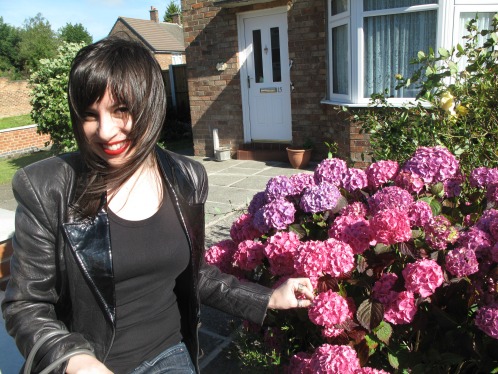
After, I stopped to pinch (physically pinch, not steal!) a flower across the street from Paul’s house. Click for my previous flower-pinching escapades.
Colin, Sylvia’s husband, did the tour for Mendips, where John lived with Aunt Mimi. There were some old drawings by John and other memorabilia but it would have been nice to have some photos of him in the space like we had at Paul’s house. Still, I had a great moment standing in his tiny bedroom and looking out the window and thinking, “John looked out this window!” Someone else who did that on a tour years ago was Bob Dylan. Yep, Bob did the fan-boy thing and took the National Trust tour, which I found interesting because Bob knew John. In fact, Dylan was the one who introduced the Beatles to pot in 1964. (In 2012, The Atlantic called the Dylan-Lennon relationship weird and one-sided, but maybe it wasn’t as weirdly one-sided as thought.) I also checked out Aunt Mimi’s room, walked out, then ran back in so I could fluff my hair and check my lipstick in Aunt Mimi’s mirror, just so I could say that I primped in Aunt Mimi’s mirror. Clearly Bob Dylan’s not the only weird one here.
Of course, we went to the basement-level Cavern Club, where the Beatles played so many of their Gladwellian 10,000 hours to hometown fans who, long before the band went on to huge success, would stop by Paul’s house to hang with the boys and get served tea by his dad, Jim. The Cavern has been rebuilt and improved after being closed in 1973 and it was still pretty dank, so imagine how it was before there were laws about fire exits and ventilation. I love the fact that people used to cram into this place with sweating walls on their lunch hour, rock out, get all smelly and go back to work/school. I’ve never done anything like that!
I can’t remember if the photo above was taken before or after I threatened MrB with divorce because I discovered he didn’t know who Stu Sutcliffe was. Stu was an artist, John’s dear friend and the original bass player for the Beatles. He died of a brain aneurysm at the age of 21. Any true Beatles fan knows who he is. Meanwhile, MrB saw the Beatles live at Candlestick Park in San Francisco in 1966 — his first wife won tickets in a radio contest. After I learned that MrB didn’t know who Stu was, I had a bad feeling about the concert issue. “You do know that Candlestick Park was the last official live concert that the Beatles ever did?” I asked. Nope, he did not! OMG! It was just like the time on Family Guy when Lois is pretending to be a big KISS fan to make Peter happy, and when he finds out, he’s bitterly disappointed in her, but then, to quote from the Family Guy wiki …
“Peter stops at a Denny’s on the way home, where KISS happens also to have stopped. Lois recognizes Chaim Witz, who she dated before he changed his name to Gene Simmons; Gene introduces her to the rest of the band, who have heard Gene’s stories of “Loose Lois.” Peter’s faith in Lois is restored, and he proudly shares the news on public access television that his wife did KISS.”
That’s exactly what this was like, except my faith hasn’t been restored by a sexual nickname.

In back of this weird-looking statue of John is a Wall of Fame listing all the artists that played at the original Cavern Club.
Now the Cavern has live music starting around noon and going all day. Plenty of Beatles tributes, of course. You’ve got the guys specializing in John and the guys specializing in Paul and so on. I always feel kinda sad for the guys who realize they have a Ringo voice, even though Ringo is awesome and the Beatles wouldn’t be the Beatles without him. When it comes to voices, you want to have the John or Paul voice. That’s just how it is. Sorry, Ringo. We stayed at the Cavern for a couple of hours but I could have stayed the whole day.
Plenty of other great bands played at the Cavern, including the Who …

… and Queen. Can you believe this factoid? This is fabulous.

We were only in Liverpool for about 2 1/2 days, and I would definitely go back and do the tours all over again, and then try for more obscure things, like the pub where Ringo used to go and so on. Also, we didn’t get to check out the museums, including a branch of the Tate and the Maritime and Slavery museums because there was a museum strike on the day we allotted for that. We did squeeze in Speke Hall, a beautiful, well-preserved Tudor house.
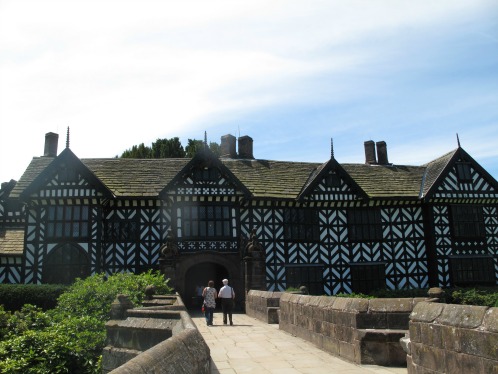
Speke Hall.
Our July trip didn’t end with Liverpool. Our next stop was London, but I’ll save that for the next post.
Note to Mark Lewisohn: Thanks for writing the book that got me to visit Liverpool at last, but your work really needs a discography of all the records that inspired the Beatles, from pre-World War II tunes to the Donays. I only realized when I got to the end of the book that I should have been writing those down so I could have a mega-Beatles-related playlist. Have someone organize that on iTunes for us, please! Kthxbai.
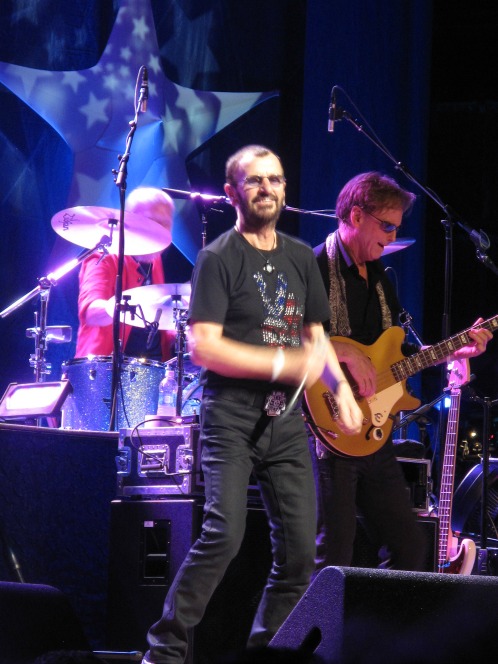
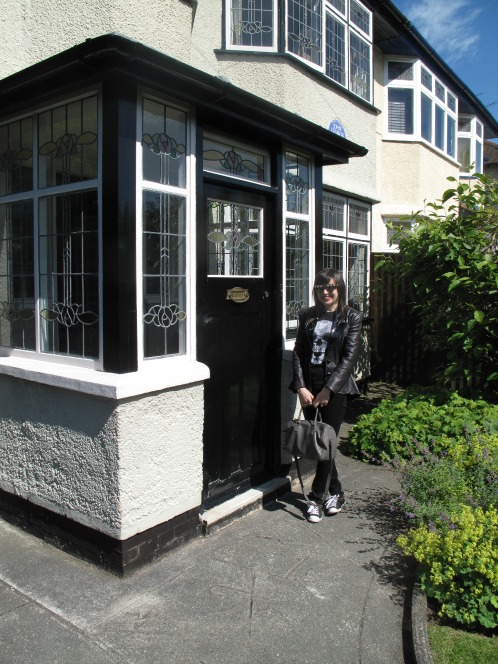
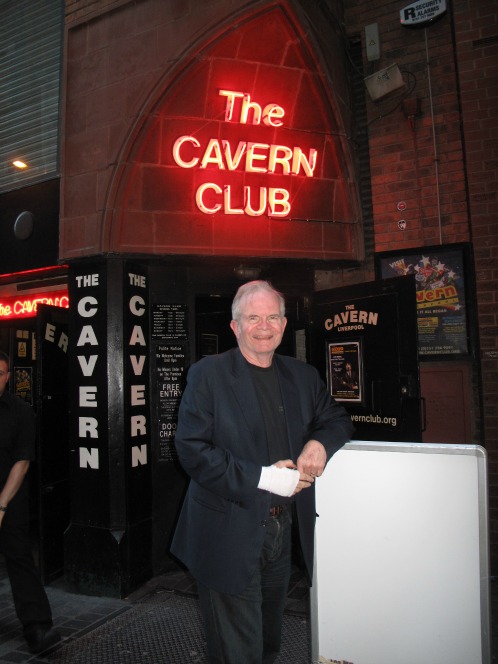
You summed up that book pretty nicely, thanks! I know you were loving it… so glad you finished. Thanks for sharing your travel photos! You sure crammed a lot into 2 1/2 days 🙂
I also loved that James quote… one of the best!
I’m telling you, that book is full of good lessons!
Holy cow – this post is all kinds of awesome. You should be an NYT book reviewer! And honestly, even I know who Stu Sutcliffe was (and I’m just a dilettante of the Beatles history). I’m surprised it took you so long to get to Liverpool given how often you go to the UK, and your obvious obsession!
OMG, you know Stu … well, MrB is just sinking further in my estimation! LMAO. By the way, I said to him haughtily, “Well, if you don’t know Stu, you OBVIOUSLY don’t know Astrid, Klaus and Jurgen, and they’re CRUCIAL.”
As for Liverpool … I guess I had to get old enough to be totally shameless about doing the fan girl thing (and also taking any days away from London). Before, it was like, “Am I really going to this non-vacation spot to kvell over the Beatles?” Now it’s all, “WHY NOT?!”
But I do credit that book with making up my mind once and for all!
I suppose it goes without saying that you’ve seen Backbeat? http://en.wikipedia.org/wiki/Backbeat_%28film%29 I watched it years ago but I remember being captivated. (Note: It’s not high-art but it’s good for the Beatles fans!)
Oh yes! I enjoyed it! And, getting away from Stu, a Beatles-related comedy that my sister and I watched over and over in the ’80s (it was always on cable!) was I Wanna Hold Your Hand. We adored that! http://en.wikipedia.org/wiki/I_Wanna_Hold_Your_Hand_%28film%29
Another fabulous history lesson, dear Wendy!! I admit to being one of “those” individuals who didn’t know all that much about the Beatles…and now I’m probably better educated than the average fan!! 😉 As a true Beatlemaniac, though, you must have been so thrilled to finally make the trip to Liverpool…looks like you squeezed a whole lot out of your 2.5 days!!
http://www.StyleIsMyPudding.blogspot.com
Yes, it was fabulous and I’m so happy I finally did it! Why put things off so long? I’m trying not to make that mistake anymore 🙂